

Seattle Cosmic convened again at Marty and Ron's apartment in Kent on 18 May 2002. Present were Marty and Ron Hale-Evans, Karl Erickson, Lindsey Dubb, John Braley, Jay Lorch, Kisa Gryphon, Chad McDaniel, Mark Purtill, Mark Haggerty, Eric Yarnell, and New Guy Meryl Douglas. Meryl is a friend of Mark H. and Eric's. She grew up in the Seattle area but is currently living in Lexington, Kentucky, Marty's hometown -- and Meryl now has the accent to prove it. Note that while we had two Marks against us (Mark Purtill and Mark Haggerty), neither Tim-1 (Tim Higgins) nor Alpha Tim (Tim Schutz), both regulars, could make it this week.
Karl Erickson came over around 2:00 PM to hang out with me and shoot the sh*t (as opposed to shooting craps; Karl doesn't like games of chance). We played a few abstract games, including a game of Tantrix that we couldn't finish because I had to get things set up for game night. Karl and Marty then played a game of Tantrix that bled past 7:00 and into game night proper.
While we were hanging out waiting for people to show up, discussion turned to the multitude of Lord of the Rings games that have appeared as movie tie-ins. Of course, the Tolkien estate has been licensing LotR games for years, and we now have a bewildering array of them to choose from. I can't keep them straight myself. Marty suggested that the next Tolkien game to be released should be titled, Lord of the Rings: This Time It's Personal.
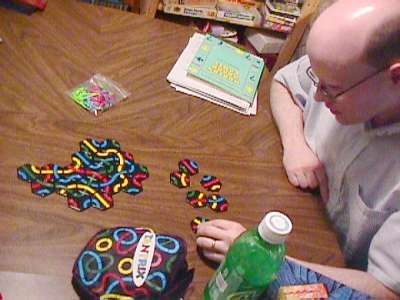
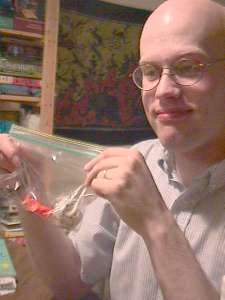
Here's the Tantrix game that Marty and Karl played while we waited for everyone to arrive. Tantrix is an interesting abstract game in which players attempt to gain the most points with either a long line or a long loop of their colour by placing hexagonal tiles. (Each tile in a loop is worth twice as much as one in a line.)
Tantrix is obviously based very heavily on the abstract strategy game Trax. Not only are you trying to make loops and lines, but the real giveaway is the "forced move" rule, which dictates that you must fill in gaps in the board of a certain type as you play. Overall, while I enjoyed what I got to play of Tantrix, I think Trax is a better game, not least because it is a pure abstract strategy game (two players, no chance, no hidden information), while Tantrix has chance and hidden information in the form of the tile bag, from which you must draw at least one tile each turn.
Karl beat Marty, 18-16, and was awarded the "rock and roll" prize -- a foam toy rock and a little wall-walker with suction cups that rolls down most any vertical surface. Karl, you left your prize here! Are you donating it back to the prize bag?
While Karl and Marty were playing, the other players started filtering in. Chad brought Die Händler to play again, eliciting groans from his friends and a query from John Braley as to whether we ought to do a "tough-love intervention".
Around 7:20 or 7:30, Chad, Jay, Eric, Lindsey, and Meryl started a game of Puerto Rico. Even though I haven't written most of those session reports yet, Puerto Rico has been hitting the Seattle Cosmic tables pretty often in the last few weeks (almost as often as Die Händler). I don't know much about it, but Marty has described it as being the love child of Citadels and Settlers of Catan -- it's a resource management game like Settlers with the become-a-different-character-every-turn mechanic of Citadels and Verrater. Here are the final scores:
Eric ..... 53 Chad ..... 47 Jay ...... 43 Lindsey .. 41 Meryl .... 34
Eric was awarded a multicoloured plastic slinky for his victory. (All slinkies awarded as prizes this week were donated by JT Thomas.)
I was running a theme table centered around spy games on Saturday. I'm going to write about the Spy Night games in sequence, so don't be surprised if the narrative seems to rewind itself to earlier in the evening when I have described the last spy game.
The first spy game on the table, at 7:45, was a nifty little appetiser of a game called Heimlich & Co., which won Wolfgang Kramer the Spiel des Jahres in 1986.
Each player is represented by a little wooden spy of a different colour, each wearing a trenchcoat and a low-brimmed fedora, as in the photo below. You are only told the colour of your own spy pawn, and must deduce the colours of the other players by how they move the pawns -- anyone can move any spy or spies, depending on the roll of the dice, and the better you can conceal your own spy's movements among the others', the better off you'll be.
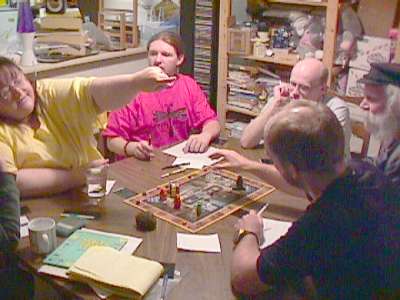
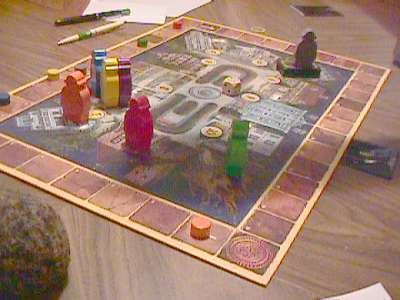
The object of the game is to score the most points, which you do by (a) ensuring that your spy is on a high-scoring space when a scoring round occurs, and (b) correctly guessing the colour of the spy of one or more of the other players. The spaces are numbered from 1 to 10, with additional -3 and 0 spaces. The scoring round occurs when one or more spies land on a space containing a secret dossier. The person who placed spies there then gets to move the dossier to a different space.
The game is more strategic than you might think, because you can often divide up your die roll among several spies. For example, if you roll a 6, you can move two pieces three spaces; or three pieces two spaces; or one piece three spaces, one piece two spaces, and one piece one space; and so on. Thus, although there is a chance element, the role of chance is lessened, and individual players often have quite good control of how spies move, when a scoring round is called, where the dossier is placed, and so on.
The first time I played Heimlich & Co., there were only two other players. I guessed both of them, for 5 points each, and won the game. (This is harder than it sounds, because some of the spies in that game belonged to no one.) I was counting on being able to guess well again this time, and after the point in the game in which players write down their guesses, I casually blew my cover and pretty obviously moved my single spy to the most advantageous position for him. Unfortunately, I guessed wrong on every single one of the other spies (all six of them), and my score was low. Kisa, however, was able to suss out most people; he says the trick is to watch which player puts which colour into a better position, not simply which player is moving which colour. Scores were as follows:
Kisa ....... 66 Mark H ..... 62 Marty ...... 56 Mark P ..... 54 Karl ....... 52 Ron ........ 35 John ....... 27
Kisa was awarded a homemade copy of the rare German deduction game Black Vienna, in which you play a police detective in postwar Germany trying to nab the three members of the infamous criminal gang Black Vienna. Tim Schutz did most of the printing and assembling of the cards for these homemade sets, and I printed instructions and score sheets. Even though it's sort of a spy game, we did not actually play it during Spy Night. (And a suggestion of Before I Kill You, Mr Bond was turned down unanimously.)
Mark Purtill suggested that next time we play a game of "Heimlich Chicken" within the main game. Players would vie to see who could play the game longest without looking at their colours. The idea for Heimlich Chicken is modelled on AquaChicken, which is a similar subgame for the game Aquarius from Looney Labs.
Next up at 9:00 PM was the game Conspiracy, published around 1982. Some people sneered at the game early in the evening because it was published by Milton Bradley, but I've said before that Milton Bradley, Parker Brothers, et al. have published some pretty good games down the years. The games just don't get republished because the American public prefers endless repackagings of Monopoly, Trivial Pursuit, and one or two other big sellers, to any game with a truly novel concept behind it. As it turned out, Conspiracy was one of the big hits of the evening along with Inkognito. (Some people liked Heimlich & Co. as well.)
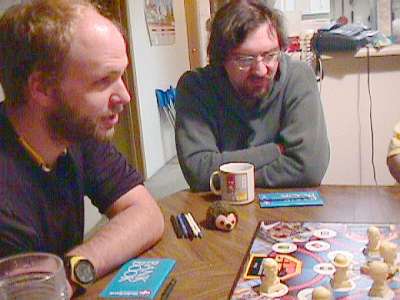
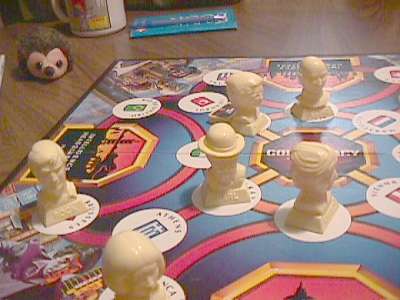
(Notice the plush hedgehog next to Mark P's mug in each photo. This was a gift from Kisa to Marty and me, because we play so many Doris & Frank games with hedgehogs in them. Is the hedgehog usurping the Space Slug's place as Seattle Cosmic mascot? What is the hedgehog's name? How many photos can you find it in this week? Is the last question too much like the "Find the Pope in the Pizza" contest? Does anybody really know what time it is? Does anybody really care?)
Karl and John sneaked off to play more two-player abstract games, as is their wont, and Marty sat this game out as an observer, because it could only take four players, so the players for this game were as follows:
Ron ....... Washington, DC Mark P .... Moscow Kisa ...... London Mark H .... Peking
Each player portrays a spymaster for a world power, and is given $10,000 with which to bribe spies. (A paltry sum, but this was 1982; I am reminded of the running gag in the Austin Powers movies. However, Marty points out, "$10,000... may be a paltry sum for Americans, but it's a year's income for several families in many parts of the world. This was something I was thinking as you moved the spies from city to city and joked about the sums of money -- that Americans' comparative wealth would allow them to buy off spies in other countries cheaply." Good point, Marty.)
The object of the game is to move a spy with the secret briefcase into your headquarters. On your turn, you can bribe a spy, attempt to move a spy, or attempt to eliminate another spy.
As in Heimlich, any player can move any spy, and it is wise to conceal which spies you have the most interest in. However, in Conspiracy, you can challenge a move made by another player by progressively revealing the amount of money with which you have bribed the spy they moved. Every revelation of a bribe amount is met with either the statement "Covered!" by the challenged player, or a statement that they cannot cover that amount. You are allowed to stop increasing your bids for the spy at any time, and you can also stop stating that the bid is covered (both useful tactics to deceive the other players at times), but you cannot overstate the amount you have on a spy. Attempts to eliminate one spy with another (that is, "assassinate" the spy in the British version, or "blow the spy's cover" in the American version) work in a similar way: challengers attempt to outbid the player initiating the assassination on his bribe for the assassin.
I came this close (one space away) from winning at one point, but Kisa was too savvy. He managed his bribe fund better and maneuvered a spy with the briefcase into London. For this he was awarded not another copy of Black Vienna (we had several for spy game prizes), but a copy of the German edition of Citadels, Ohne Furcht und Adel, which he had been coveting since Tim Higgins added it to the prize bag. (Tim said he was donating it so he himself could win it later, redonate it to the prize bag, rewin it, etc. -- but I don't think he was serious, do you?)
I liked this game enough that I hope it will see replay soon. The Seattle Cosmic game library has a copy of The GAMES AND PUZZLES Book of Modern Board Games by David Pritchard, which contains an entire chapter on strategy for The Sigma File, the British edition of Conspiracy. It also states that the game benefits from replay with the same players. Borrow the book, won't you, and be ready for Kisa next time?
Marty adds, "[Conspiracy] was interesting enough that we spontaneously started to think of variants and different ways to play. This, to me, is always an indicator that a game has at least some interesting mechanism."
At 10:30, we moved from one of the two hits of the evening to one of the two dogs of the evening. The less said about Spy Alley, the better. It's a roll-and-move clone that's so closely modelled on Monopoly it even has something like a GO space: every time you move past it, you collect money. The object is to collect four spy items for your nationality (password, disguise, code book, and key) and bring them to your embassy. As in the past two games, you may also try to guess which player is which nationality of spy; if you guess correctly, that player is eliminated from the game, but if you guess incorrectly, you are.
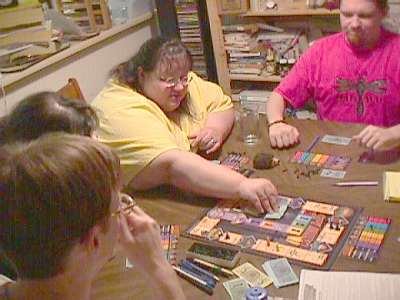
The five players for this game were me, Eric, Mark Purtill, Marty, and Kisa. After three or four rounds, we voted to quit the game and just guess one another's nationalities. I guessed first. I was lucky that Eric had reacted visibly when he landed on the American embassy's space and I joked, "Did you win yet?" (It also helped he had only collected items for two nationalities, and one was American.) I therefore guessed correctly that Eric was American. I took his ID and mixed it up with mine, then discarded one, per the rules. Mark and Marty then made guesses, but both were wrong and were eliminated. Kisa passed on his turn (hey! can you do that?), hoping that I would guess wrongly, but I had a good idea of the nationality he must be by having seen who the others were, so I correctly guessed he was French, and won our hasty Spy Alley get-it-out-of-here variant.
I should have known. Spy Alley received lots of awards, including a listing in the 1998 Games 100, but many of the awards were from parent/teacher groups, and one was from Mensa. I can't think of a game that has won the Mensa Brain Game award that I have actually liked. This isn't sour grapes; I used to be in Mensa. It's just that Mensa gets a couple of hundred people together for a weekend and gives each of them thirty games to judge in that short time. Players don't even have to finish their games to give them thumbs-up. Talk about flawed methodology. As we put Spy Alley away, Mark Purtill related how he had once read a game review that mentioned the game in question had won a Mensa award. "But don't let that fool you!" the reviewer continued. "This game is actually pretty good!"
Mark Purtill noted that you could play Spy Alley Chicken as well as Heimlich Chicken. Actually, not looking at your nationality is one of the strategies listed on the Spy Alley website, on the theory that you can't give away what you don't know yourself. Maybe that "strategy" should have been a tipoff to me...
Mark P. left after Spy Alley.
Next up at 11:15, the Table 2 gang (Mark Haggerty, Eric, Chad, and Jay) commandeered Inkognito, which had been thoughtfully loaned to us by Chris Sjoholm of Third Place Gamers. This too proved to be a big hit. Each player becomes one of four secret agents (Lord Fiddlebottom, Colonel Bubble, Madame Zsa Zsa (the contortionist, vrowwr!), or Agent X). Lord F. and Colonel B. are partners, as are Madame Z. and Agent X. However, it is carnival time at Venice, and everyone is in costume. The object is first to discover which player is your partner from among the other three, as well as which of their four pawns represents their character, and second, to accomplish a secret mission, which you can only discover by comparing mission cards with your partner. Again, a deduction/bluffing game like the other three we had already played, but unlike Spy Alley, a good one.
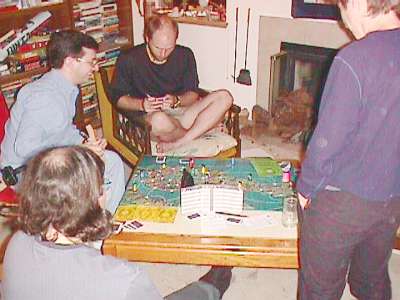
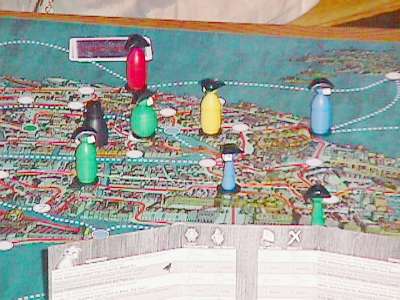
Permissible movements on a turn are indicated by shaking the Harbinger, an enigmatic figure about the size of a kid's piggybank. The marbles that come out indicate the kinds of route you can take: red means a land route, blue a sea route, yellow means either, and white means neither. Black means you can move the Ambassador, who belongs to no player in particular but does figure in some missions. (Marty adds, "The Harbinger is a really weird concept and a strange mechanism, but it's strangely attractive. Good design.")
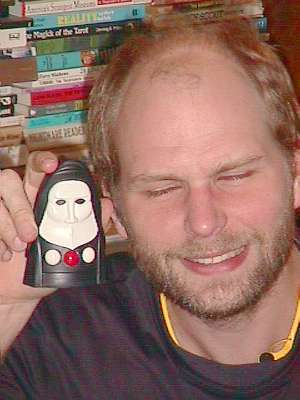
Mark Haggerty and Eric turned out to be Agent X and Zsa Zsa, respectively, and won the game by accomplishing their mission, for which they were each given a copy of Black Vienna. Several people (among them me) vowed to order a copy of Inkognito the next time the club places an order from Adam Spielt (Chris Sjoholm picked it up in our last order).
It was 11:30, and unfortunately, the closer for our spy theme evening (I Am Not A Number, an Icehouse game based on the TV series The Prisoner), was even worse than Spy Alley. The series depicts a sinister place called The Village to which "retired" spies are kidnapped by an apparently worldwide conspiracy. The TV show has been a cult favourite for 30 years or so. For instance, there is (or was) one film society at Yale devoted to showing the entire series every year on the big screen.
The object of the game is to escape from The Village, just as the eponymous hero attempted to do in every episode of the show. It is "an infamous Icehouse game", as Kisa put it, but curse designers who create games with tempting themes and then don't playtest them! To the best of our knowledge, we are the first and only group ever to play this game. I won't go into detail here, but the mechanics just don't work, even after Kisa asked for rule clarifications from the designer on the Icehouse list. Kisa played Number One (the gamemaster), so I'm hoping he will provide some feedback to "Buddha" Buck, the designer. If he does, I'll append it as a postscript to this page. (Are you listening, Kisa?)
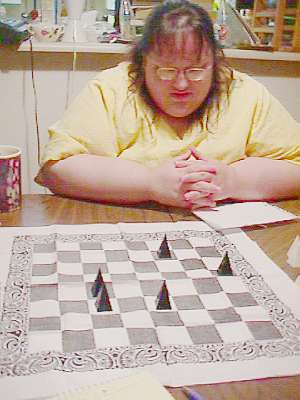
I disqualified myself from winning the game by stupidly looking over when I heard Marty talking to Kisa, and glimpsing Kisa revealing the secret colours of the pyramids under the black pyramids on the board, when I should have kept my back to him. I probably would have been more careful if I had given one-third of a damn about the outcome of the game. Meryl and Lindsey got Black Vienna prizes just for surviving this fiasco.
Fascinating concept, extremely flawed execution. After three turns, the game broke down and we all quit. I guess in that sense, we escaped The Village after all. Remind me to tell you some time about my idea for a hacked "Kobayashi Maru" version of the old Apple II game, The Prisoner...
And now please step into the Wayback Machine. We're returning to 10:15 PM, after Table 2 finished Puerto Rico and began playing Zendo. Players included Mark Haggerty, Jay, Meryl, Chad, and Lindsey.
Unlike I Am Not A Number, Zendo is a good Icehouse game, one of
the best. Each turn, someone plays a Zen Master and the other players
are his students in the Zendo. The students must guess the secret
rule the Master uses to create "koans", or assemblages of Icehouse
pieces. According to Jay Lorch, three rounds of Zendo were played, as
follows:
Round 1
-------
Master: Chad
Rule: The number of big pieces and little pieces must be the same.
Winner: Lindsey
Round 2
-------
Master: Lindsey
Rule: No two touching pieces may have the same size or color.
Winner: Jay
Round 3
-------
Master: Mark
Rule: There must be exactly three pieces.
Winner: Jay
Sorry, no pictures. If you want to see what a Zendo game looks like, check out the newsletter for 30 March 2002, "Cake, Candles, and Cosmic".
I usually award the player who won the most rounds of an evening's Zendo game a prize, so Jay, I owe you one.
And now back in time to 9:00 PM at Table 3, to which Karl and John had slipped so they could play some two-player abstract games in peace. Their first game was Tantrix. Karl beat John, 48 to 21, quite a feat considering John is an ex-Chess master and widely considered the best strategist in the group. Marty should be proud; Karl only beat her by 2 points! (I think I owe Karl a prize for this game. Should I give him the Rock and Roll package when I see him?)
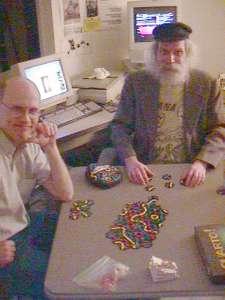
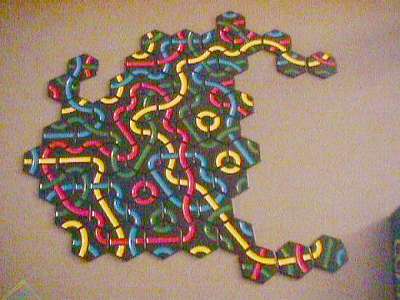
In the background behind John you can see the SETI@Home application chugging away on our legacy Mac. In case you're not familiar with this program, it's a screensaver that lets you donate spare CPU cycles on your networked computer to a Search for Extra-Terrestrial Intelligence project at Berkeley. Why not check it out? Clients are available for Windows, Mac, and GNU/Linux. Or, if you think SETI is too speculative and fanciful, and you have a Windows computer, why not donate some processing time to the United Devices project, which will use it to analyse potential cancer drugs?
Let me know if you're interested in doing this stuff; perhaps we can form a Seattle Cosmic team or a Ludic Synergy team for one of these projects.
Here's something to know about John Braley: he plays really slowly. So slowly that when I remarked to Karl that the tiles in his Tantrix bag might easily be "brailled" by an expert player (that is, checked with the fingers for the right pattern on the surface, as Scrabble players sometimes do when drawing tiles), he thought I said "Braleyed" and asked, "What do you mean? Played really slowly?" Anyway, Karl started up a game of Quarto with John, simultaneous with the Tantrix game, just so he could have something to think about while John was calculating his moves.
John won the Quarto game, for which he was awarded a coloured slinky.
Next Karl and John broke out my Focus (a.k.a. Domination) set, a favourite of all three of us. When I asked Karl who won the Focus game, he said, "Guess." I guess that he's still smarting from John's infamous victory during The Night of Intense Focus.
John won a folding Japanese fan for the hot weather ahead.
Karl left at 12:15, Lindsey and John at 12:40. Mark Haggerty, Eric, Meryl, and Jay left at 1:00 AM. The only people remaining were me, Marty and Kisa. Kisa is a gamin' fool, and Marty and I didn't have to drive home, so we tackled a Bruno Faidutti game called Castle that Kisa had just picked up at a Wizards of the Coast sale. It was fun, but I don't think I'll buy it, even at 50% off.
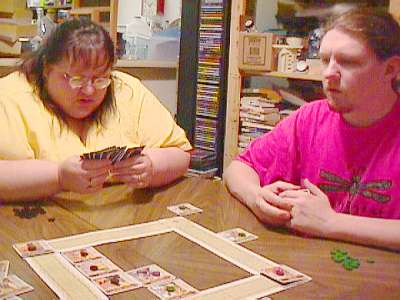
The object of the game is to empty your hand by laying cards down at strategic positions on the board. Each card has a special power that lets it move other cards around or return them to players' hands.
Kisa emptied his hand first, and won a coloured slinky. It was a very close game; I would have won on the next turn, and Marty would have won on the turn after that.
Kisa had won the most spy games (he won Heimlich & Co. and Conspiracy), so he was declared Spymaster for the evening, and was awarded his own complete (used) copy of the Conspiracy game. He returned the favour by donating two more games to the Seattle Cosmic game library: Picture Picture (which Scrutineyes fans should enjoy -- are you listening, Meredith?), and Four Letter Frenzy, a sort of alphabetic Spoons variant wherein the spoons are replaced by purple beanbags called "Frenzy Bags", a name that Marty thought hilarious at 1:45 in the morning, which is when we finished Castle and Kisa went home.
As I write this, the sun is coming up on Tuesday morning. Amazing what you can get done if you don't sleep.
The Center for Ludic Synergy and Seattle Cosmic Game Night are now associates of Funagain Games. This means that 5% of your purchase there goes toward supporting us if you buy games there via the following links or the Funagain logo at the bottom of the page.
Even if you don't want to buy the games, the Funagain pages often contain lengthy, useful game reviews.
Friday, 24 May 2002, 7:00 PM in West Seattle. Come play for fun and FABULOUS PRIZES!
Remember, Seattle Cosmic Game Night occurs every weekend, in one of three locations: West Seattle, Mill Creek, or Kent. Email Ron Hale-Evans for a full schedule. If you come, please bring a snack or drink to share (cookies, chips, soda, juice, etc.).

Seattle Cosmic Game Night Home | Center for Ludic Synergy home
All photos on this page copyright © 2002 by Ron Hale-Evans except where otherwise noted.
Maintainer: Ron Hale-Evans, rwhe@ludism.org
Page last updated 2002-05-21.